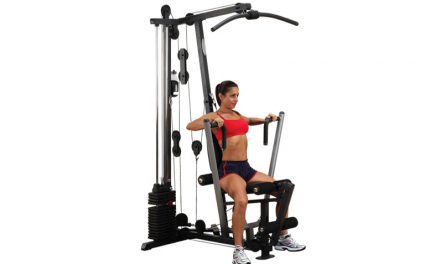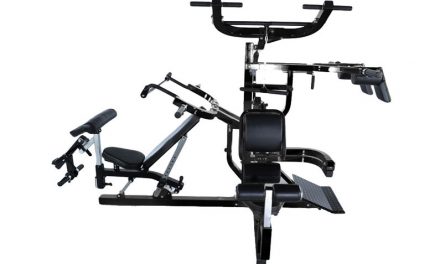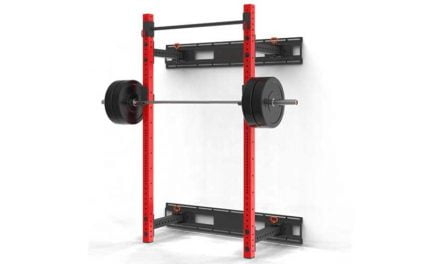Here’s what we know… if you’re into weight training, power racks will help you maximize your efforts.
That’s a promise.
Any strength training coach or bodybuilder will tell you that the best power rack will make a great addition to any home gym.
You’ll find that it’s arguably one of the best equipment to use, especially with barbells.
Not to be mistaken for regular squat racks or half racks, power racks, also called a power cage, allow the user to perform multiple barbell workouts without any of the restrictions you typically get from machines.
Unlike squat racks or half racks, power cages come with four posts and are enclosed to provide safety and flexibility for its users.
Some of the best power racks are designed for durability. They’ll have 14 gauge steel or better and may even include some powder coating for added longevity.
Some are typically bolted down to the floor to give it more stability but in most cases that won’t really be necessary.
Its versatility makes it one of the best tools available and allows you to perform many different exercises that will help with strength and muscle growth.
Commercial and collegiate gyms possess at least one and in many cases multiple power racks for their members/users.
Body builders and power lifters have found them to be a vital piece of equipment for training.
Don’t skimp out on power racks and don’t be that guy that builds a homemade one out of wood.
Sure, they’ll do for the time being but just wait till you start hearing the cracks.
Here’s a list of the top 5 power racks under $500
| Power Cage | Specs (Dimensions only cover the entire frame including bottom brace) | Weight Capacity | |
|---|---|---|---|
 | Fitness Reality 810XLT Super Max Power Cage | Dimensions: 23.5” L x 59” W x 48.5” H Bar 2x2, 14 gauge steel. | 800 lbs. |
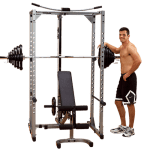 | PowerLine by Body-Solid Power Rack (PPR200X) | Dimensions: 44"" L x 46"" W x 82"" H Bar 2x2, 12 gauge steel. | 600 lbs. |
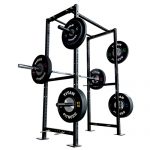 | Titan X-2 Series Power Rack | Dimensions: 28"" L x 46"" W x 87"" H Bar 2x2, 9 gauge steel. | 3000 lbs. |
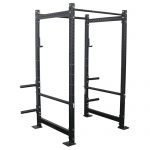 | Titan T-3 Series Short Power Rack 36" Depth V2 | Dimensions: 44.75"" L x 53.25"" W x 82.25"" H Bar 2x3, 11 gauge steel. | 1100 lbs. |
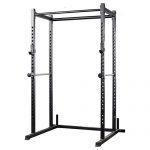 | Rep Power Rack – PR-1000 | Dimensions: 48"" L x 48"" W x 83"" H Bar 2x3, 11 gauge steel. | 1000 lbs. |
Benefits
There are number of reasons why weight lifters have favored power racks. Some of their added benefits include:
- Versatility
- Safety
- Durability
- No Spotter Required
- Vast Number of Exercises
Versatility
You can perform various compound exercises along with other strength training exercises much more safely.
Fortunately, most of the cages come with a pull up bar and some even come with optional dip bars.
Some of the many exercises include
- Rack Lockouts
- Pull Ups
- Dips (Optional Equipment)
- Bench Press
- Squats
- Shoulder Press
- Deadlifts
- Rows
- Partials
Safety Features
Power racks are built with four vertical metal posts stabilized/bolted together for stability.
Within these posts are holes used to insert the safety bars and lift offs.
The height of the bars/lift offs are adjustable.
There are two adjustable safety bars or “barbell catch” used to “catch” the barbells preventing it from falling on you in the event you can’t complete a lift.
Lift offs are used as starting points to hold the barbell and are adjustable to allow users of any height to perform exercises.
For whatever reason, however, many don’t use it properly thus rendering the safety feature useless.
You’ll notice some people squat outside of the cage which is ok but they’re not utilizing the safety feature that was made specifically for such routines.
Durability
Most power racks are incredibly durable so you can expect it to last you a lifetime.
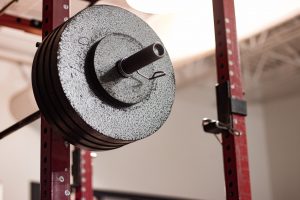
Photo by Lance Goyke
Most, if not all are constructed with thick gauge steel tubing and built to withstand a lot of abuse.
Of course it depends on the make and model to determine its strength and maximum weight.
Some hold as little as 300 lbs. and upwards to 1000 lbs. or more.
Four vertical posts are linked or bolted together at the top and bottom for stability.
No Spotter Required
Thanks to the catch bars, you can perform all of the compounded exercises without having to worry about dropping the weights onto yourself.
The bars can be adjusted to fit any height and feel free to go as heavy as you want.
Number of Exercises
It’s difficult to provide a specific number of exercises you can do with a power rack. Depending on the make and model, you can have added accessories that will allow any user the ability to add a few more workout routines.
But when it comes to the fundamentals, power racks alone can compensate for all of the routines listed above.
What About Price?
Price varies widely with these types of equipment.
It can range anywhere between $200 to over $1000.
The price point doesn’t necessarily reflect quality.
In some cases, the size (dimensions), added equipment, and other factors affect the price point.
As with most fitness equipment, you would think that you get what you pay for but surprisingly, you can find very good power racks at the lower price range.
Things to Consider
- Weight Capacity: Some power racks hold as little as 300 lbs. which may be ok for some but it’s suggested that you focus on purchasing one that has a higher load capacity so you don’t grow out of it. Look at the suggested max weight, grade, and the weight of the unit itself to determine how much it can handle. If the unit has an 11 gauge or thicker steel frame, you can bet it can handle at least 800+ lbs.
- Grade: It’s important to know the correlation between the weight capacity and grade of the rack. The lighter the grade, the less weight it will hold. Commercial or light commercial grades are the preferred choice over the home models although most manufacturers are now beefing up their bottom models due to market demands. If you’re a heavy lifter or have the motivation, look for the gauge (thickness) of the metal along with the thickness of the frame. The lower the gauge, the thicker the steel, e.g. 12 gauge is thicker than 14 gauge. Try to focus on 12 gauge or thicker.
- Unit Weight: The heavier the rack, the better. The units weight and grade guarantees stability and reliability when training.
- Height: Power racks typically fall between 79 inches to 90+ inches. Make sure to take careful measurements from floor to ceiling of the location you intend on placing the rack. Don’t forget to account for any flooring or accessories that may affect the height of the rack.
- Hole Spacing: The hole spacing allows the users to adjust the safety bars and lift offs to comfortable levels. Users of varying heights can safely use the barbell both inside and outside the rack. Depending on the user, the hole spacing may be an important factor. 3 to 4 inch spacing works for some but to fit a greater range of users, 2 inch spacing is recommended. If you select a rack with 3 to 4 inch spaces, you can improvise when needed by adding some footing to the bench or the area you stand on. Buy a Power Rack
In case the benefits listed weren’t enough to convince you, here’s another reason why buying a power rack is essential for anyone who is serious about weight training.
If you haven’t heard already, at some point you’ll hear that nothing compares to free weights.
When it comes to muscle development and strength training, that happens to be a fact.
No other piece of equipment can help you utilize free weights more effectively and/or safely.
There are literally no restrictions in your movements and the catch bars are all you need in the event you need to drop the weights.
If you’re serious about muscle development or strength training, get a power rack, you won’t regret it.


